On the Road with Fred and Barb - Newsletter #23
Aug. 20-26 Stewart, British Columbia to Smithers, BC
Aug. 20-22 Stewart to Prince Rupert
Despite the rain and clouds, the drive to Prince Rupert
was very scenic. The road hugs the shoreline of the Skeena River most
of the way and we could see that we would be surrounded by mountains
if the clouds weren't so low. 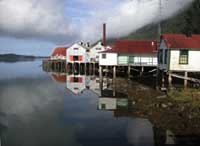 Just
outside Prince Rupert is the small town of Port Edward which is home
to a historic fishing village and cannery. The tour of the old cannery
was really interesting. The cannery started operation in 1889 and continued
until 1960. It was amazing looking at the old photos of the workers
and hearing how they used to process the fish before any automated machines.
In the mid 30's, the cannery was automated with lots of big, noisy machines
to make the cans, machines to chop off the heads and tails, gut the
fish, chop it up and fill the cans. The machines still work and our
tour guide threw a switch and gave us a demo. I don't know which would
have been worse - working in the cannery before or after automation.
Both were very repetitious and messy but I could not have stood the
noise of the machines. And the workers didn't have ear protection then.
Just
outside Prince Rupert is the small town of Port Edward which is home
to a historic fishing village and cannery. The tour of the old cannery
was really interesting. The cannery started operation in 1889 and continued
until 1960. It was amazing looking at the old photos of the workers
and hearing how they used to process the fish before any automated machines.
In the mid 30's, the cannery was automated with lots of big, noisy machines
to make the cans, machines to chop off the heads and tails, gut the
fish, chop it up and fill the cans. The machines still work and our
tour guide threw a switch and gave us a demo. I don't know which would
have been worse - working in the cannery before or after automation.
Both were very repetitious and messy but I could not have stood the
noise of the machines. And the workers didn't have ear protection then.
The rain has continued to hamper outdoor activity so we
opted for a visit to another museum - this one the Museum of Northern
British Columbia. It was one of the best ones we've seen with lots of
interesting displays of the early life of First Nations' people. The
museum offered free guided tours describing the exhibits. For a little
extra, we signed up to attend a simulated potlatch or celebration feast.
We even became members of certain clans - our group was the Eagle clan
and Barb played chief. There were dances, story telling and sampling
of native food. We tried soapberries but found them quite bitter even
though sugar had been added. Then dried seaweed, which they call popcorn.
It was crunchy and salty but I'll take our popcorn anyday. Lots of fun
and a great way to learn about native culture.
Steve and Robbie had planned to take the ferry over to
Vancouver Island but were wait listed (no reservations available until
Aug.31.) They got up bright and early to be in line at 5:30 am but unfortunately
didn't get on. Rather than try again on Monday they decided to hightail
it down to Vancouver area as there is a Winnabago dealer there that
they hope can fix their slideout. We decided to proceed back a little
slower so we said our goodbbyes. We have really enjoyed their company
on this trip and will miss our game nights.
Aug. 23-24 Prince Rupert to Terrace
Terrace lies about 90 miles east of Prince Rupert along
the Skeena River. We finally got a break in the weather and were able
to see what we had missed when we traveled the route on the way to Prince
Rupert. The Terrace area is noted for its salmon fishing and if our
freezer wasn't already full we would have tossed in a line. Instead
we decided to take two sidetrips by car that were very nice. 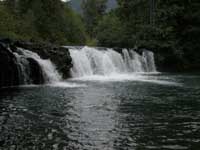 The
first was to the Nisga'a Memorial Lava Bed Park about 45 miles north.
The volcano that created the beds erupted about 250 years ago, wiping
out some Indian villages near its base.We took a couple nice walks onto
the lava beds and out to some picturesque water falls.
The
first was to the Nisga'a Memorial Lava Bed Park about 45 miles north.
The volcano that created the beds erupted about 250 years ago, wiping
out some Indian villages near its base.We took a couple nice walks onto
the lava beds and out to some picturesque water falls.
The next day we drove about 30 miles south to the town
of Kitimat. This is a planned city that was founded in 1953. The reason
for its existence is due to the building of a huge ALCAN factory - the
largest in North America. They offer free tours of the complex where
you can watch aluminum being made. What a fascinating tour. After a
25 minute video overview, we boarded a bus and drove out to the end
of their wharf where we watched the finished product being loaded onto
huge ships. The Kitimat port is one of the busiest on the West Coast
and is ice free year round. Then the bus entered one of the smelting
buildings. We had to leave our watches, credit cards and key alarms
behind as the building is electromagnetically charged. The guide handed
us a few paper clips and they stood upright on the palm of our hand,
proving that everything inside the factory becomes magnetized. The process
for making aluminum involves passing an electric current through a powdery
substance called alumina. That turns it molten and the whole smelter
consists of about a hundred of these furnaces. From the smelter, we
proceeded over to casting where they pour the molton aluminum into molds.
These are shipped to customers who turn it into aluminum foil, window
frames, auto parts, etc. Unfortunately, we couldn't take pictures as
cameras would have been ruined!
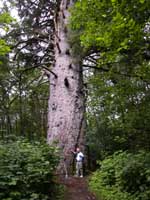 Kitimat
also has the distinction of having the largest living Sitka Spruce tree
in British Columbia. It is over 500 years old and measures 139 feet
tall. They say it would provide enough lumber to frame nine average
houses.
Kitimat
also has the distinction of having the largest living Sitka Spruce tree
in British Columbia. It is over 500 years old and measures 139 feet
tall. They say it would provide enough lumber to frame nine average
houses.
Aug. 25-26 Terrace to Smithers
From Terrace it was a short drive to our camp spot for
the night, the KSAN campground and museum in Hazelton. This is a beautiful
campground run by a First Nation clan.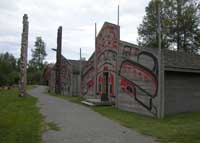 The site also includes a historical village and museum, a replica of
a traditional Gitksan Indian village that stood at this site for centuries.
Within walking distance of the campground is Old Hazelton.
The site also includes a historical village and museum, a replica of
a traditional Gitksan Indian village that stood at this site for centuries.
Within walking distance of the campground is Old Hazelton. 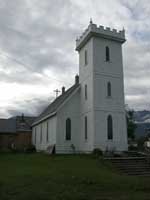 The
town has been reconstructed to look much like it did in the 1890's.
This Anglican church was built in 1900 and has the original bell in
its tower.
The
town has been reconstructed to look much like it did in the 1890's.
This Anglican church was built in 1900 and has the original bell in
its tower.
We are now in Smithers, a cute town nestled below some
towering mountains and glaciers. The storefronts on Main street have
been made to resemble an Alpine Village. We took the visitor center's
suggested circle tour of the surrounding area and were glad we did.
It took us up to the Driftwood Canyon Provincial Park which is the site
of some fossil beds in the shale outcroppings along the creekbank. Then
we drove along a dirt road (pretty smooth) through farmland. Supposedly
you might see wildlife along the way but all we saw were cows wandering
across the road. There were some great views of the Glacier and we found
some wild raspberries to pick along the route. 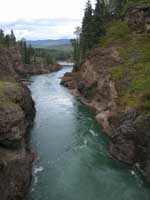 We
crossed over the Bulkley River and Moricetown Canyon and Falls where
natives were fishing for salmon.
We
crossed over the Bulkley River and Moricetown Canyon and Falls where
natives were fishing for salmon.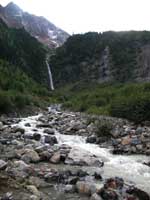 Then drove up to Twin Falls, two magnificent falls that thunder down
from the Hudson Bay Mountain and glacier. The whole route took about
three hours - a nice way to spend the afternoon.
Then drove up to Twin Falls, two magnificent falls that thunder down
from the Hudson Bay Mountain and glacier. The whole route took about
three hours - a nice way to spend the afternoon.
We are now off to Prince George where we've had some mail
forwarded. Will be there till it comes.

